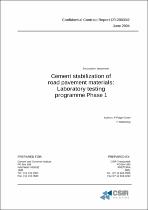 ResearchSpace
ResearchSpace
Cement stabilization of road pavement materials: laboratory testing programme phase 1
JavaScript is disabled for your browser. Some features of this site may not work without it.
- ResearchSpace
- →
- Archives collection
- →
- Open Access Reports
- →
- View Item
| dc.contributor.author |
Paige-Green, P

|
|
| dc.contributor.author |
Netterberg, F

|
|
| dc.date.accessioned | 2009-03-05T14:27:25Z | |
| dc.date.available | 2009-03-05T14:27:25Z | |
| dc.date.issued | 2004-06 | |
| dc.identifier.citation | Paige-Green, P and Netterberg, F. 2004. Cement stabilization of road pavement materials: laboratory testing programme phase 1. Report prepared by the CSIR for Cement and Concrete Institute, pp 101 | en |
| dc.identifier.uri | http://hdl.handle.net/10204/3142 | |
| dc.description | CSIR Transportek, in collaboration with VKE, Soillab and Frank Netterberg, was contracted by the Cement and Concrete Institute to investigate the influence of the new SABS EN 197-1 cement specifications on the use of cement as a road material stabilizer | en |
| dc.description.abstract | The introduction of the SABS EN 197-1 (SANS 50197-1) specification for cements in South Africa resulted in a change in the range of cements available for material stabilization for road layers. An investigation was carried out to assess the impact of seven of the available cements on two typical South African construction materials. Chemical analyses of the two materials showed no incidences of unusual components that would lead to specific problems during cement stabilization of the materials. There is no doubt that both conditioning time and material temperature during the early stages of hydration of the cement affect the compacted density and unconfined compressive strength and indirect tensile strength (these three are obviously interrelated) negatively. However, comparison with one documented example indicates that the current cements probably have an equal or even lesser effect in this regard than the older cements. No dominant trends relating to the behaviour of the different cements could be isolated during the project. It is clear, however, that the combination of cement type and material under the expected construction conditions will affect the density and strength of material obtained in the field. On this basis, all potential construction materials that are to be stabilized should be tested with the cements likely to be used on the proposed project and under the expected ambient conditions to identify the expected allowable construction time and the combination which provides the longest workability/ construction time should be selected | en |
| dc.description.sponsorship | Cement and Concrete Institute | en |
| dc.language.iso | en | en |
| dc.publisher | Cement and Concrete Institute | en |
| dc.relation.ispartofseries | Confidential Contract Report | en |
| dc.relation.ispartofseries | CR-2003/42 | en |
| dc.subject | Cement stabilization | en |
| dc.subject | Cement properties | en |
| dc.subject | Construction material | en |
| dc.title | Cement stabilization of road pavement materials: laboratory testing programme phase 1 | en |
| dc.type | Report | en |
| dc.identifier.apacitation | Paige-Green, P., & Netterberg, F. (2004). <i>Cement stabilization of road pavement materials: laboratory testing programme phase 1</i> (Confidential Contract Report). Cement and Concrete Institute. Retrieved from http://hdl.handle.net/10204/3142 | en_ZA |
| dc.identifier.chicagocitation | Paige-Green, P, and F Netterberg <i>Cement stabilization of road pavement materials: laboratory testing programme phase 1.</i> Confidential Contract Report. Cement and Concrete Institute, 2004. http://hdl.handle.net/10204/3142 | en_ZA |
| dc.identifier.vancouvercitation | Paige-Green P, Netterberg F. Cement stabilization of road pavement materials: laboratory testing programme phase 1. 2004 [cited yyyy month dd]. Available from: http://hdl.handle.net/10204/3142 | en_ZA |
| dc.identifier.ris | TY - Report AU - Paige-Green, P AU - Netterberg, F AB - The introduction of the SABS EN 197-1 (SANS 50197-1) specification for cements in South Africa resulted in a change in the range of cements available for material stabilization for road layers. An investigation was carried out to assess the impact of seven of the available cements on two typical South African construction materials. Chemical analyses of the two materials showed no incidences of unusual components that would lead to specific problems during cement stabilization of the materials. There is no doubt that both conditioning time and material temperature during the early stages of hydration of the cement affect the compacted density and unconfined compressive strength and indirect tensile strength (these three are obviously interrelated) negatively. However, comparison with one documented example indicates that the current cements probably have an equal or even lesser effect in this regard than the older cements. No dominant trends relating to the behaviour of the different cements could be isolated during the project. It is clear, however, that the combination of cement type and material under the expected construction conditions will affect the density and strength of material obtained in the field. On this basis, all potential construction materials that are to be stabilized should be tested with the cements likely to be used on the proposed project and under the expected ambient conditions to identify the expected allowable construction time and the combination which provides the longest workability/ construction time should be selected DA - 2004-06 DB - ResearchSpace DP - CSIR KW - Cement stabilization KW - Cement properties KW - Construction material LK - https://researchspace.csir.co.za PY - 2004 T1 - Cement stabilization of road pavement materials: laboratory testing programme phase 1 TI - Cement stabilization of road pavement materials: laboratory testing programme phase 1 UR - http://hdl.handle.net/10204/3142 ER - | en_ZA |





